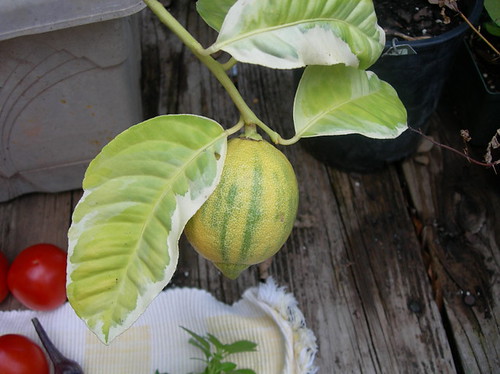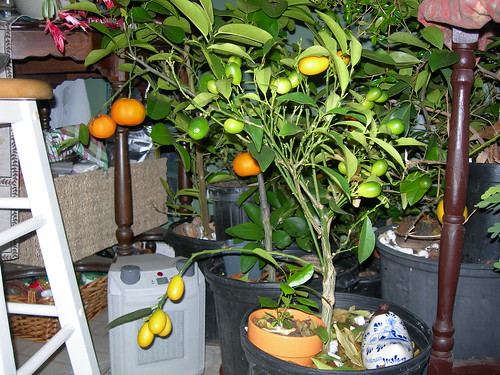How to Grow Citrus in Pots
Appalachian residents don’t usually think of citrus as a local food but if you have a sunny window or greenhouse to overwinter your plants, you can grow citrus indoors.
Citrus require a moderate amount of maintenance to thrive but they can be very rewarding. The first thing to do is obtain some plants. If you are driving to Florida anytime soon, swing by a garden nursery on your way home. Otherwise, you will need to go to local garden centers that carry houseplants (citrus is most often for sale locally in the summer) or order from a catalog:
- Citrus from One Green World
- Citrus from Logee’s Tropical Plants
- Citrus from Brite Leaf Citrus Nursery, LLC
- Citrus from Four Winds Growers
Dwarf citrus trees give the most success in pots and they are all closely related with similar needs.

Photo Caption: Green when unripe, dwarf grapefruit trees also do well in pots. This one is showing a nutrient deficiency which can be remedied with fertilizer.
Once you have your citrus you can treat it similarly to other houseplants. They (like most houseplants) enjoy soil that is about as damp as a wrung-out sponge. It is okay (and advisable) to let the top 1″ – 2″ of soil dry out between waterings. It’s better to underwater than overwater citrus — soaked soil promotes root rot. These plants are somewhat drought tolerant but they do not appreciate drying out completely. Their sturdy leaves will not wilt to give you a warning that water is needed — if you wait too long they pout, sometimes days later, by dropping all their leaves and fruit. If this does happen, don’t worry, your tree will soon regrow leaves and flower again.
Citrus is also a heavy feeder compared to other houseplants and being from a warm climate it likes to be fed year-round. I add an organic slow-release fertilizer (with micronutrients) and an inch or two of compost every month or two. Underfed plants will develop nutrient deficiencies in a short amount of time. You can use this photo guide to identify the problem and add the correct amendment to your plant’s soil.
Another citrus requirement if you would like to have fruit is pollination. If your plant is indoors, insects can’t do this for you. Keep a small paintbrush near your citrus when it is flowering and dab a little pollen from the stamens onto the sticky pistils. You can also just use your fingertip. Pretty soon your citrus will start to form tiny fruits!
Sour citrus ripens faster than sweet citrus and both can stay on the tree for a very long time even when ripe. Sweet citrus usually bears once a year whereas sour citrus can have up to 3 crops annually.
After your frost-free date, move your plants outdoors into the heavy shade and slowly harden them off to bright sunlight. They may lose their leaves anyway since indoor citrus produce larger leaves to absorb dimmer light — outdoors they will not need as much surface area to gather light with. Your citrus may not appreciate full sun outside, they can get by with as little as 4 hours direct sun a day. Be sure to water them often enough in the heat of summer!
If you get scale or spider mites while your plants are indoors, treat them with insecticidal soap. It usually takes multiple applications to fully eradicate the problem. If you can move the plants outdoors, the beneficial insects and animals in the area will usually consume the pests for you.
If you’d like to know more try Citrus by Lance Walheim:
If you’re looking for my post on hardy citrus, you can find it here.
8 thoughts on “How to Grow Citrus in Pots”
Comments are closed.




Anna - February 15, 2010 7:39 pm
Just stumbled across you today — can’t for the life of me remember how I got here, but it’s great to find another sustainahillbilly.
We have a dwarf Meyer lemon and love it! It’s a hungry beast, like you said, but I’ve found that feeding it the “tea” that comes out of the worm bin keeps it pretty happy as long as I top-dress it with compost now and then.
After our success with the lemon, we decided to expand last year into a dwarf tangerine. It’s a beautiful plant now, but doesn’t seem to want to bloom. It looks like you’ve got a fruiting tangerine there — did you do anything special? How old was it when it started to fruit?
Sustainahillbilly
Twitter: appalachianfeet
- February 16, 2010 9:21 am
Hi! Wonderful to have a fellow sustainahillbilly commenting on the site!
I can’t remember how old my tangerine was when it started fruiting, I think it was only about 3 years old. It may be that your worm tea/compost is very high in nitrogen (which is good for leaf production) but not high in Phosphorus (which promotes blooms). The other necessary element is bright sunlight.
I’ve also heard that letting your plant dry out a bit before watering can shock it into blooming, but that could also shock it into dropping its leaves so be careful.
Anna - February 16, 2010 12:59 pm
I’ll bet my tangerine is just two young. I’ve only had it for a year, after all! I just wondered because I’ve had my lemon for a year longer and it fruited at this age (and is fruiting again!) Since I treat the two exactly the same, presumably the nutrients are right for the tangerine (unless tangerines need something different!)
Thanks for coming over to visit on my blog.
Anna - February 16, 2010 1:38 pm
Ahem, I meant “too young.”
veronica - September 13, 2010 11:50 pm
i bought a dwarf patio lemon called lotsa lemons..within 2 mths it was dead i must admit i have never had any success with growing anything in pots and all they end up doing is getting smaller or sicker until they eventually snuff it..i water under water feed do everything and it still does help..we do live in brisbane and the climate is humid we dont get alot of rain so i dont know what im doing wrong but i have given up on pots all together.
Pingback: How to Grow Tasty Citrus Outside in Zone 7+ (Tangerines, Grapefruit, Oranges, & More) | Appalachian Feet
Barb - November 22, 2012 11:36 am
Nice article on citrus but you don’t say what the optimum fertilizer N-P-K should be for citrus.
Several years ago, I received a 10 year old potted grapefruit which had (and still has) never bloomed. I put it on the patio for 6 months and into a cold, barely-heated building in winter near a big south window.
My nursery doesn’t offer “citrus fertilizer”, so I have no idea what ratio of NPK it should receive.
Sustainahillbilly
Twitter: appalachianfeet
- January 16, 2013 10:01 am
Sorry about that. There’s info on fertilizing citrus in